Eric Poindron in La Bastide-Puylaurent |

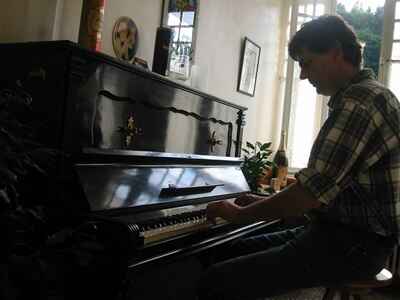 Are you eating with us? The trout was caught this afternoon and the soup is homemade. Plus, I offer the aperitif... It's the owner of L'Etoile Maison d'hôtes in La Bastide-Puylaurent - one thousand twenty-four meters - a friendly giant about thirty-five years old who makes the invitation before showing the room. Two beds, a sink, and an old bistro table with a wooden top for evening writings. View over the Allier. The donkey has made her own. She will sleep in a barn, at the foot of the river, near an old bridge. She seems to appreciate the place. Here even the ducks look like they're on vacation.
Are you eating with us? The trout was caught this afternoon and the soup is homemade. Plus, I offer the aperitif... It's the owner of L'Etoile Maison d'hôtes in La Bastide-Puylaurent - one thousand twenty-four meters - a friendly giant about thirty-five years old who makes the invitation before showing the room. Two beds, a sink, and an old bistro table with a wooden top for evening writings. View over the Allier. The donkey has made her own. She will sleep in a barn, at the foot of the river, near an old bridge. She seems to appreciate the place. Here even the ducks look like they're on vacation.
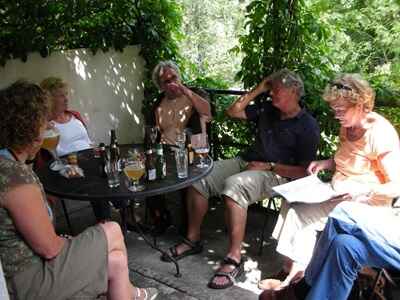 Have you come from far away? - After Saint-Flour-de-Mercoire, we followed the river as closely as possible, avoiding Fouzillic and Fouzillac due to the weather and Cheylard-l'Evêque to arrive before evening. At Luc, it was straight ahead, or almost. We wanted to climb to the trap of the abbey Notre Dame des Neiges, but with the donkey it was complicated... No regrets. According to our host, we made the right choice. It's high and still far, despite the clear night, we would have gotten lost. You have to know, it's wild up there. And then the inn is only open to retreaters.
Have you come from far away? - After Saint-Flour-de-Mercoire, we followed the river as closely as possible, avoiding Fouzillic and Fouzillac due to the weather and Cheylard-l'Evêque to arrive before evening. At Luc, it was straight ahead, or almost. We wanted to climb to the trap of the abbey Notre Dame des Neiges, but with the donkey it was complicated... No regrets. According to our host, we made the right choice. It's high and still far, despite the clear night, we would have gotten lost. You have to know, it's wild up there. And then the inn is only open to retreaters.
Belgian beer for everyone? And away we go, Belgian beer for everyone. We are settled in front of the fire in the large room that serves both for meals and relaxation when two new hikers drop their bags: Raoul, a Stephanian, and Graeme, an Englishman from Bristol. Finally arriving is Billy, the ginger labrador from the gîte. Outside the cities, there's no need for long introductions. We don't display colors, we don't raise any flag. The backpacks are enough for complicity.
The owner returns with arms full of dried fruits. The tongues are loosening. After hiking, a guy who dines with you becomes your friend. Questions of journey. The only one who explains is the owner of the gîte: - My name is Philippe Papadimitriou, I am half Belgian, half Greek and the rest of the time Lozerien. Before settling in La Bastide-Puylaurent, attaching himself to Lozere, he wandered around Australia, searched for gold in California, and crossed France on horseback. That's how he discovered Lozere and fell in love with the place. Two horses, his girlfriend with a horse, and two dogs. He settled down and, six months later, he started the gîte.
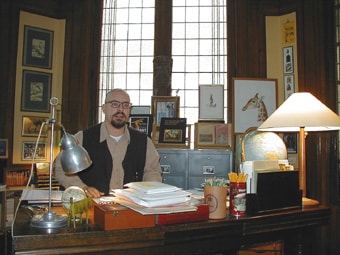 I love it, I feel like I have a boat. Since then, I’ve been putting in a push. Life is precious. Then he tells the little history of his house, once a family boarding house as it should be, the hotel Ranc. Monsieur used to take his wife and children to get some fresh air and hurried off to meet his mistress on the Riviera. Philippe seeks to preserve the family boarding house aspect, even for one night. "When you leave my place, you should have only one desire, to return as soon as possible."
I love it, I feel like I have a boat. Since then, I’ve been putting in a push. Life is precious. Then he tells the little history of his house, once a family boarding house as it should be, the hotel Ranc. Monsieur used to take his wife and children to get some fresh air and hurried off to meet his mistress on the Riviera. Philippe seeks to preserve the family boarding house aspect, even for one night. "When you leave my place, you should have only one desire, to return as soon as possible."
He spares no effort to increase his loyal clientele: impeccable food, spacious rooms, unique atmosphere. Not to mention the dry humor and a great aptitude for happiness. Philippe has the sacred fire, he refuses to give up, "even if this country is not his, precisely because this country is not his." He curses the labor force that seeks to win Le Puy-en-Velay, Saint-etienne, or the South. What will they do more in Montpellier? But he blames no one, he knows that twenty-five years in Lozere can give desires for elsewhere and a definitive escape. He enjoys himself here.
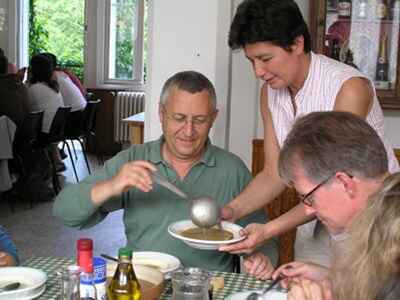 The soup smells like the garden, the flesh of the trout is firm and the homemade crepes are served without restriction. The little stylish wine from Notre-Dame-des-Neiges accompanies the whole. Fruit wine and communion wine, everything goes down the same tube. If Stevenson had known the guesthouse L'Etoile, there’s no doubt he would have stayed. At the table, everyone shares their anecdotes, their disordered impressions of the places they have crossed. Raoul the Stephanian recounts his exploits. He went to Corsica this summer. Graeme, the slender Englishman, specialist in German romanticism and Sturm und Drang, moderates the importance of Stevenson on English soil. As if in regret. - Travels with a donkey in the Cevennes, for us, it's a children's book, a dictation book. A charming text to learn spelling. Then he displays his manual, a little red book, illustrated and dog-eared, which accompanies him during his hike. - When I talked about my trip to my friends, they were astonished. In our country, Stevenson is a storyteller of beautiful stories, a popular writer...
The soup smells like the garden, the flesh of the trout is firm and the homemade crepes are served without restriction. The little stylish wine from Notre-Dame-des-Neiges accompanies the whole. Fruit wine and communion wine, everything goes down the same tube. If Stevenson had known the guesthouse L'Etoile, there’s no doubt he would have stayed. At the table, everyone shares their anecdotes, their disordered impressions of the places they have crossed. Raoul the Stephanian recounts his exploits. He went to Corsica this summer. Graeme, the slender Englishman, specialist in German romanticism and Sturm und Drang, moderates the importance of Stevenson on English soil. As if in regret. - Travels with a donkey in the Cevennes, for us, it's a children's book, a dictation book. A charming text to learn spelling. Then he displays his manual, a little red book, illustrated and dog-eared, which accompanies him during his hike. - When I talked about my trip to my friends, they were astonished. In our country, Stevenson is a storyteller of beautiful stories, a popular writer...
A French teacher for several years in Languedoc, it’s in France that Graeme discovered the Journey. He does not regret the hike and wants to finish without delay because for him, in Saint-Jean-du-Gard, it’s the end of the holidays. He has to return to England in a few days. He raises his glass to French encounters.
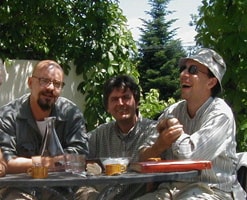 Philippe takes the opportunity to bring coffee, pear brandy, and Belgian cinnamon cookies. He sets down the tray and grabs his guitar... "I traveled the world and California, I put my hands in the mud to find gold, I’m a gold seeker." Singing Dylan, Neil Young, Eagles, and his own repertoire - of which he has no reason to be ashamed - he continues his story of a modern cowboy.
Philippe takes the opportunity to bring coffee, pear brandy, and Belgian cinnamon cookies. He sets down the tray and grabs his guitar... "I traveled the world and California, I put my hands in the mud to find gold, I’m a gold seeker." Singing Dylan, Neil Young, Eagles, and his own repertoire - of which he has no reason to be ashamed - he continues his story of a modern cowboy.
A log in the hearth and the folk ambiance settles in. This boots are made for walking... Raoul takes the opportunity to monitor his emerging blisters. Coffee, beer, and Leonard Cohen. The songs warm you up. After the beautiful star, the beautiful gîte of L'Etoile. When Graeme the Englishman asks the Belgo-Greek if he has read "Travels with a donkey in the Cevennes", the other smiles: - I’ve read two books in my life. My library is my head. On the road at fourteen. Working on farms, sleeping in barns and then America. There they are, my books.
Monks in the mountains. And I gave thanks to God for being free to wander, free to hope, free to love...
***

At the exit of La Bastide-Puylaurent, in the dense forest, wedged between Vivarais and Gévaudan, we are looking for the path that leads to the trap, a retreat place for the monks. The sun manages to illuminate the beeches, ashes, and firs like a summer morning. Noah's load is weighed down with a few sandwiches prepared by Philippe.
Sound of foliage. A pedestrian emerges from the woods and hides a basket of mushrooms behind his back. He is a farmer and talkative. "Why are you doing that?" He points to our shoes and mimics carrying a backpack. - "We do 'that' because if we hadn't, we wouldn't have met... - That's not stupid... there's a lot of 'that' with the good man. Satisfied with the answer he considers simple but sensible, he unpacks everything he knows, or thinks he knows, about the trap. Regarding the turnover, it is whispered in the village - not him, mind you! - that it is one of the most important in Ardèche. The second after the cement factories. You must not repeat it, that's what they say, not him, right... "They also say" that Brother Régis, the superior, is on familiar terms with the most important political leaders of Ardèche. He even nicknames a local oil Jeannot!
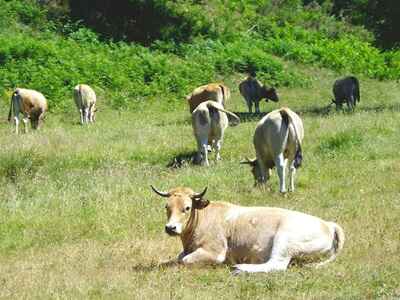 Our informant reveals other confidences, other rumors verified by the cousin's sister or by our man himself... - Don’t repeat it either, all the political and economic decisions in the region are made up there. In the village, on winter evenings, some have seen official cars going up to Notre Dame des Neiges. Only in winter, on snowy or foggy evenings. When no one hangs around in the streets... Listening to him, the trap seems like an Ardèche Monopoly. The man continues: - I quite like the brothers but generally, in La Bastide, there is a lot of jealousy. The monks are poorly seen. People do not like their quiet success. The monks may suffer a bit from it, but after all, it suits them to be left alone. Before turning on his heels, inadvertently or out of trust, he pulls his basket from his back and leaves us with these words: - Are my vines beautiful?
Our informant reveals other confidences, other rumors verified by the cousin's sister or by our man himself... - Don’t repeat it either, all the political and economic decisions in the region are made up there. In the village, on winter evenings, some have seen official cars going up to Notre Dame des Neiges. Only in winter, on snowy or foggy evenings. When no one hangs around in the streets... Listening to him, the trap seems like an Ardèche Monopoly. The man continues: - I quite like the brothers but generally, in La Bastide, there is a lot of jealousy. The monks are poorly seen. People do not like their quiet success. The monks may suffer a bit from it, but after all, it suits them to be left alone. Before turning on his heels, inadvertently or out of trust, he pulls his basket from his back and leaves us with these words: - Are my vines beautiful?
Notre-Dame-des-Neiges... In the bare and cold fields surrounding the trap, a 4L turns in all directions like a swarm of crows. "Brother Zéphyrin, he is always on the roads around the trap, you will see, he is a very kind man," said Philippe. He comes in our direction. We introduce ourselves. The monk with the lovely pink face and laughing eyes places his hunting rifle on the passenger seat. Responsible for the agricultural operation, he takes care of the cows and the woods. This morning, he is looking for fresh traces of wild boars. - They came last night, they start by eating a mouse, and then the whole family passes by. The monk with a face as round as the moon's behind is also a racing car enthusiast. - If I hadn't been a monk, I would have been a driver. Not necessarily a world champion, but a good driver. When a car race is prepared, it is useless to look for Brother Zéphyrin. He always finds a good reason to go racing in town. And then, on occasion, he goes down to drink a beer at L'Etoile, provided it is brewed by Cistercian Trappists, as required by the brotherhood. He directs us to the trap's bar. - Brother Jean will be happy to serve you the aperitif and have a little conversation.
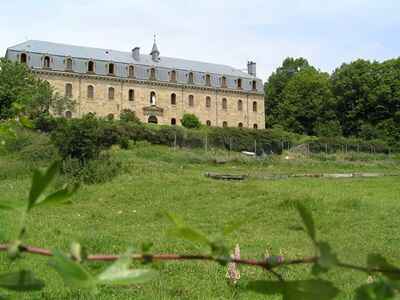 Brother Jean stands behind the counter, about twenty meters long. He promotes Quineige, an aperitif developed and sold by the monks. The bistro brother serves every day of the year without exception and has only left the trap once in twenty years. "To go to the toubi, otherwise I don't have time, I have to work hard, even at night sometimes." A jack-of-all-trades, he serves, smiles, and monitors the entries and exits of provisions. The bar resembles an Ali Baba cave dedicated to the lady Food. They sell barrels of all sizes, hollow Virgins - to fill, decorated carafes, chestnut jam, regional sweets, wine, and spirits!
Brother Jean stands behind the counter, about twenty meters long. He promotes Quineige, an aperitif developed and sold by the monks. The bistro brother serves every day of the year without exception and has only left the trap once in twenty years. "To go to the toubi, otherwise I don't have time, I have to work hard, even at night sometimes." A jack-of-all-trades, he serves, smiles, and monitors the entries and exits of provisions. The bar resembles an Ali Baba cave dedicated to the lady Food. They sell barrels of all sizes, hollow Virgins - to fill, decorated carafes, chestnut jam, regional sweets, wine, and spirits!
Brother Jean carries his eighty years like others carry luck. He must be about one meter fifty tall and climbs on an old wooden box to bring his face to counter height. Behind him, Auvergne hams, monumental sausages, and cheeses patiently wait to be taken down. Brother Jean is used to working and holding a conversation. Like a guide, he tells the life of the monks, the history of the trap, and its functioning...
At the end of the 11th century, Robert de Molesme and Saint Bernard left the Benedictines of the Cluny Order. They wished to find a more rigorous faith and apply the teaching of Saint Benedict. The Benedictines share their time between prayer and study; we Cistercians add physical work... Moreover, Brother François-Régis, the superior, is absent; he is monitoring the grape harvest in Bellegarde, between Nîmes and Tarascon. That is where we buy our grapes. We trust, of course, but it is better to be on site. We buy a nice Merlot. Go to the cellars to taste it...
 Despite the many visitors who wish to place orders, the monk takes his time. Brother Jean is not in a hurry. He weighs a heavy mountain sausage and pitches it to a little round lady who is getting impatient. A cohort of tourists waits their turn. While he serves, the brother grocer continues his lecture. The first trap was reduced to ashes in 1912. Today, thirty-five monks live in the mountains and silence according to the rules laid down by Saint Benedict. Prayer and work. "They will really be monks if they live from the work of their hands," said the saint.
Despite the many visitors who wish to place orders, the monk takes his time. Brother Jean is not in a hurry. He weighs a heavy mountain sausage and pitches it to a little round lady who is getting impatient. A cohort of tourists waits their turn. While he serves, the brother grocer continues his lecture. The first trap was reduced to ashes in 1912. Today, thirty-five monks live in the mountains and silence according to the rules laid down by Saint Benedict. Prayer and work. "They will really be monks if they live from the work of their hands," said the saint.
The monks pray four hours a day, from the office at four-thirty to the one at nine... Today, many young people are tempted by a temporary or permanent isolation to piece together the puzzle. Thus, this hiker who arrived with a backpack, who, after a short retreat, never left again. Here, one can live apart from the grand spectacle and, at the same time, undertake a spiritual and personal journey within oneself. In the middle of the forest and at the heart of the world, like Saint Francis.
Upon closer inspection, there are two traps clinging to the mountain. The first for the monks, invited religious, and lay retreatants, the second for tourists, great consumers of holy pork, rosaries, and napkin rings with the likeness of Charles de Foucauld - who stayed here in 1890 before dying in the Sahara desert in 1916. At the trap, the visitor can pray and consume in peace. The brothers of the mountain accept all magnetic cards.
Like that of all Cistercian monks, the day of the Ardèche monk begins with waking up at four o'clock, followed by the office where the psalms are sung. From five to seven o'clock, meditation and personal reading occupy the monk. At seven o'clock, the lauds come in honor of Creation, the Eucharist - always with great sobriety. During the rest of the morning, the monks engage in their professional activities, according to the rules laid down by Saint Benedict... Cooking, sewing, farm work, beekeeping, wine work. Lunch is taken in silence, and the afternoon is again devoted to manual activities, then around six-thirty, the vespers are celebrated in silence and reflection. After a frugal supper, the monks attend the compline, the last ceremony of the day addressed to the Heavenly Father and Mary. All then retire to their cells for the night. Saint Benedict invites the monks to contemplation to better overcome the agitation of the outside world.
 Brother Jean tells with a glimmer of grace and forgiveness in his eyes. We have been told - a lot of "one" in the Ardèche mountains - that he maintains his good humor, his monastic calm, or his divine optimism from another stay in a cell, this time of horror. He was a "resident" at Auschwitz and promised to enter religion if he got out of the nightmare. The miraculous brother, with a face marked by suffering, with eyes burning like the biblical bush, is a mix of magnificent beggar engraved by Jacques Callot and a victim drawn in ink by Zoran Music in the camps of the abominable. When leaving the giant pantry, the brother who crushes our hand smiles once again.
Brother Jean tells with a glimmer of grace and forgiveness in his eyes. We have been told - a lot of "one" in the Ardèche mountains - that he maintains his good humor, his monastic calm, or his divine optimism from another stay in a cell, this time of horror. He was a "resident" at Auschwitz and promised to enter religion if he got out of the nightmare. The miraculous brother, with a face marked by suffering, with eyes burning like the biblical bush, is a mix of magnificent beggar engraved by Jacques Callot and a victim drawn in ink by Zoran Music in the camps of the abominable. When leaving the giant pantry, the brother who crushes our hand smiles once again.
After tying Noah, a long walk within the trap. The long austere buildings, the silence, and the blue sky calm the visitor and force him to bow. At the top of a mountain, in what could almost resemble a fortified estate, there is no flashy architecture, only a bell tower rises. The crossing monks smile and greet silently.
In the shop, we expand the small business by offering visitors lapel pins, ridiculous painted metal pieces that the customer can pin on the edge of his jacket, decorated plates, varnished sticks for those who feel like pilgrims, and many works dedicated to the order. No trace of the Scotsman, I specify it because an English couple absolutely wants to bring back a souvenir - "you understand, we came especially from London, we are retracing Stevenson's journey in a Jaguar coupe..." In the monastic silence, one could almost hear the sweet music of the cash register.
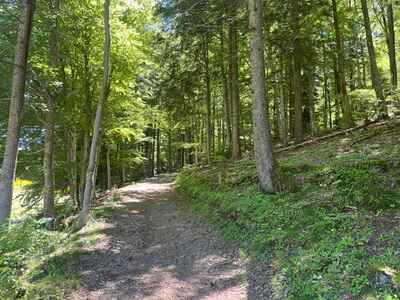 In the cellar,
the wines age in oak barrels. The monks of the Abbey Notre Dame des Neiges in Ardèche buy the grapes, vinify, and monitor the aging. We taste immediately - well, from the
barrel - a simple, honest, and fleshy Merlot, a country wine as rocky as the winemakers who produce it. For aging and selling, the monks hire additional staff - from the wine technician to the mechanic, from the agricultural worker to the carpenter, thus contributing to lowering local unemployment rates.
In the cellar,
the wines age in oak barrels. The monks of the Abbey Notre Dame des Neiges in Ardèche buy the grapes, vinify, and monitor the aging. We taste immediately - well, from the
barrel - a simple, honest, and fleshy Merlot, a country wine as rocky as the winemakers who produce it. For aging and selling, the monks hire additional staff - from the wine technician to the mechanic, from the agricultural worker to the carpenter, thus contributing to lowering local unemployment rates.
In the silence of the tuff vaults, tourists extend their cups and employees hustle at the foot of the stainless steel tanks like at a gas station on the highway of the sun. The long corridors house the giant barrels and the blessed wines. Amen! The highlight of the production is the Fleur des neiges, a sparkling wine that poet Kenneth White sometimes enjoyed, when he lived and meditated in Gourgounel, his retreat a few leagues from here.
At the sawmill, brother "grumpy" supervises the cuts. Philippe Papadimitriou, the Greek from L'Etoile, is preparing to load the few pieces of fir he has negotiated for the impressive chimney of the guesthouse. With the time of a helping hand, we become lumberjacks according to the monastic rule. Prayer and work; prayer will come later.
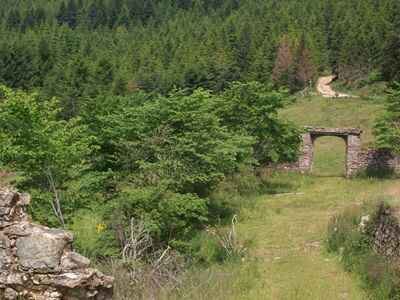 The accommodation at the trap is full, we will have to content ourselves with the forest. We are directed to the mas de Félgière, an old house of prayer and charity that remained standing
after the Revolution. "After the last buildings, it's straight ahead, follow the gorse... Get supplies at brother Jean's and go lie down in the grass." Slow walk
with Noah, who always hesitates to put her delicate hooves in the rainwater. The day dwindles over the cedars and pines, the blues of the sky give way to the first orange and
flaming glimmers of twilight. A wild pheasant appears. Long seconds face to face. The pheasant flies away. Will we see, tonight, the short-winged and round-eyed owl that my grandfather told me about? How to recognize it? If I hear a hoot, it will be a tawny owl. Nothing simpler.
The accommodation at the trap is full, we will have to content ourselves with the forest. We are directed to the mas de Félgière, an old house of prayer and charity that remained standing
after the Revolution. "After the last buildings, it's straight ahead, follow the gorse... Get supplies at brother Jean's and go lie down in the grass." Slow walk
with Noah, who always hesitates to put her delicate hooves in the rainwater. The day dwindles over the cedars and pines, the blues of the sky give way to the first orange and
flaming glimmers of twilight. A wild pheasant appears. Long seconds face to face. The pheasant flies away. Will we see, tonight, the short-winged and round-eyed owl that my grandfather told me about? How to recognize it? If I hear a hoot, it will be a tawny owl. Nothing simpler.
On September 26, 1878, after four or five days of walking, wandering, and negotiating with Modestine, Robert Louis Stevenson stops at the trap. He approaches it, filled with sincere anxiety. The son of a Scottish Presbyterian, he does not know and fears the welcome that awaits him in the Catholic enclosure. Brother Apollinaire, wheelbarrow in hand, is pleased to meet his first Scotsman. The other monks hurry...
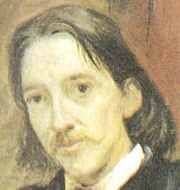 The porter brothers, the hospitalers, and finally the abbot who receives Stevenson. During his stay, he observes the life of the monks as a learned entomologist and compares the monastery to his own
experiences of communities - more devoted to the cult of wine, women, and revolution than to prayer.
The porter brothers, the hospitalers, and finally the abbot who receives Stevenson. During his stay, he observes the life of the monks as a learned entomologist and compares the monastery to his own
experiences of communities - more devoted to the cult of wine, women, and revolution than to prayer.
The superior, Father Michel, offers the newcomer the aperitif and dinner. At the table, the writer meets a country priest and a retired soldier who show intolerance towards other faiths. While threatening the Scottish traveler with hell and vigorously condemning Protestantism - "it is a sect, nothing more, nothing less" - they try to convert him. Stevenson gets a bit angry but maintains a distinctly Scottish politeness. He defends the religion of his mother and his childhood, then leaves the two devotees to their sectarian faith.At the invitation of an Irish brother, he visits the library where Chateaubriand, Hugo, and the mischievous Molière stand alongside the foundational and sacred texts. Then, in the evening, he finds himself alone in a cell. Stevenson questions his own faith, which he tries to disguise as best he can. He fears silence, solitude, and compares the monks to living dead. He also notes in his journey a cheerful French song to better mask his state of soul... The doubts will come later.
What beautiful girls you have,
Giroflée,
Girofla !
What beautiful girls you have,
Love will count them!
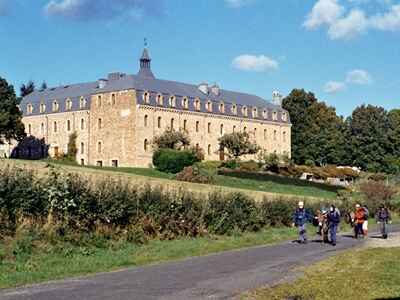 Behind the
song and the book he intends for the public, a feverish and little-known Stevenson opens up without disguise. This is the other Stevenson, the one from the Journal and the
harsh road. A pilgrim who does not realize it and doubts in the silence of Vivarais. A feverish pilgrim in search of love, of faith, who seeks to silence his mystical mood.
Stevenson writes a Prayer to friends that he will not include in the book. He has taken care to specify that a journey is, at best, a piece of autobiography.
Behind the
song and the book he intends for the public, a feverish and little-known Stevenson opens up without disguise. This is the other Stevenson, the one from the Journal and the
harsh road. A pilgrim who does not realize it and doubts in the silence of Vivarais. A feverish pilgrim in search of love, of faith, who seeks to silence his mystical mood.
Stevenson writes a Prayer to friends that he will not include in the book. He has taken care to specify that a journey is, at best, a piece of autobiography.
You who have given us love for the woman and friendship for the man, keep alive in us the feeling of communion and lasting tenderness; let us forget offenses and remember the services rendered; protect those we love in all things and accompany them with kindness, so that they lead a simple and suffering-free life and finally die in peace and with a calm spirit.
 At Notre-Dame-des-Neiges,
in the heart of the world and far from the world, a young man falls asleep. The childhood chimera - the tormented stories, the nightmares, and the old legends - are revived. A young
man prey to hesitations, to inner tremors and to piety falls asleep in the heart of the world and far from the world. Behind the emotions he seeks to make disappear, the questions that
await answers - always the same ones - arise like a specter.
At Notre-Dame-des-Neiges,
in the heart of the world and far from the world, a young man falls asleep. The childhood chimera - the tormented stories, the nightmares, and the old legends - are revived. A young
man prey to hesitations, to inner tremors and to piety falls asleep in the heart of the world and far from the world. Behind the emotions he seeks to make disappear, the questions that
await answers - always the same ones - arise like a specter.
Stevenson has accounts to settle with Scotland, which he will leave forever, without actually leaving it: Scotland of childhood, of spiritual formation and demons; Scotland of suffering and austere education; affective Scotland of the first steps on the heath, of suburbs and black towns. He has other accounts to settle with the family because, in choosing to love Fanny, he has opposed his father. This inflexible Presbyterian father, who exerts a financial and moral yoke over the child. And behind the father, England and the literary milieu that hates waves, at least those who create them... Stevenson will rebel, and the rebellion will give birth to the writer...
When he creates, during adolescence, with cousin Bob and other agitators among their friends, a small secret and provocative society, one of the first articles is a rejection of everything the parents may have taught. A motto that speaks for itself.
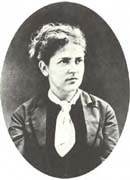 Stevenson also has accounts to settle with faith and its doubts, a
sneaky mixture of religious resurgence - does not his first text, self-published by his father, address the rebellion of Scottish Puritans? - and atheism, even
anticlericalism. Finally, there is Fanny, always Fanny, the subject of the journey and (un)reason mistress. She is behind each of the words, each of her
soft steps, each of her thoughts. Fanny, his ten years older, both woman, mother, and father. Fanny, the adventurer who disregards conventions and the literary coach. Fanny, the woman
to come. Future.
Stevenson also has accounts to settle with faith and its doubts, a
sneaky mixture of religious resurgence - does not his first text, self-published by his father, address the rebellion of Scottish Puritans? - and atheism, even
anticlericalism. Finally, there is Fanny, always Fanny, the subject of the journey and (un)reason mistress. She is behind each of the words, each of her
soft steps, each of her thoughts. Fanny, his ten years older, both woman, mother, and father. Fanny, the adventurer who disregards conventions and the literary coach. Fanny, the woman
to come. Future.
Lying in my sleeping bag, by the fire in a dark barn, I reread and compare the texts. In the travel journal, Stevenson pours out and gives in to his honest emotions. In the Journey, he moderates his hesitant faith and finds a sharp tone. He crosses out, deletes his personal experiences. Anyone wishing to travel with Stevenson in the Cevennes must equip themselves with the Travel Journal to discover the other side. The Hyde mystery. The secret meaning, as he wrote in his preface. Only there does the man reveal himself. The definitive, rewritten edition gives pride of place to the flashy writer, and this Travel Journal is a seismograph of the spirit. Back in shelter, in front of a desk, Stevenson intervened on the seismograph, tempered his warm reflections, and censored himself. by Eric Poindron. Beautiful stars. With Stevenson in the Cevennes. Publisher: Flammarion. Collection: Gulliver.
Former holiday hotel with a garden along the Allier, L'Etoile Guest House is located in La Bastide-Puylaurent between Lozere, Ardeche, and the Cevennes in the mountains of Southern France. At the crossroads of GR®7, GR®70 Stevenson Path, GR®72, GR®700 Regordane Way, GR®470 Allier River springs and gorges, GRP® Cevenol, Ardechoise Mountains, Margeride. Numerous loop trails for hiking and one-day biking excursions. Ideal for a relaxing and hiking getaway.
Copyright©etoile.fr